Lithium ESS battery systems: an asset to reduce commercial electricity bills
An EHS system:
An asset to reduce commercial electricity bills
Electrical contractors specializing in energy efficiency are constantly looking for ways to reduce their commercial customers’ electricity bills. One of the emerging levers is the integration of Energy Storage Systems ( ESS)) battery-powered LFP. By the way, high-voltage DC battery systems are often better suited for commercial needs .
These high-capacity batteries allow for better management of electrical power called by a building and eliminate unnecessary spikes in demand, resulting in substantial savings on the Hydro-Québec. How can an ESS reduce the Power Charges charged to business customers? By popularizing the concepts of Peak shaving , real-time power management, and demand anticipation, we’ll see how the battery can smooth consumption, reduce billable peaks, and optimize the cost of electricity for your customers.
In response to this rapid growth, new legislation has been put in place to ensure the safety and reliability of electrical installations in Canada.
It is important for both the end user and the professional installer to ensure the quality of the selected batteries. On the one hand, it is possible to ensure the safety of the electrical installations and, on the other hand, to ensure the reliability and profitability of the installation in the long term.
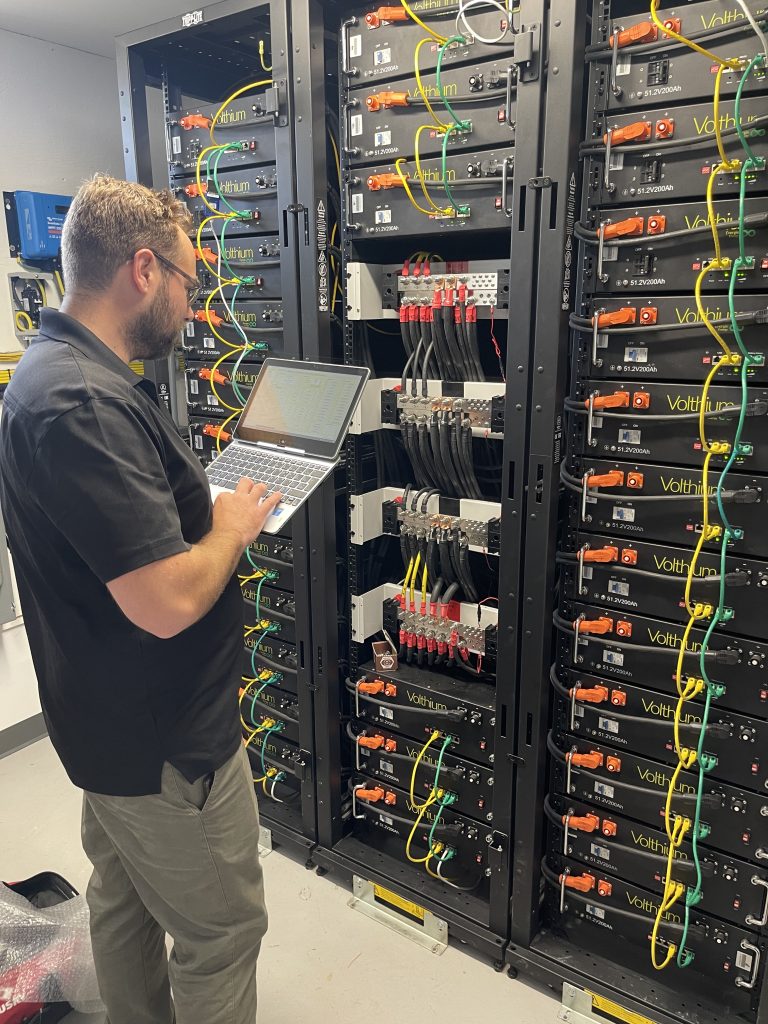
Understanding Power Charges
Hydro-Québec
To fully understand the interest of peak shaving, we must first understand how HydroQuébec bills electricity to business customers.
Unlike residential customers, medium and large power commercial customers are billed on two components: the energy consumed (in kWh) and the peak demand power (in kW).
In practice, the distributor measures consumption at regular intervals (often every 15 minutes) and records the maximum peak power reached during the month. The latter determines the Application Fee (or power charges) added to the bill.
For example, at the general rate M (medium-power customers), as soon as a customer exceeds 50 kW of power demand, each kilowatt of peak power is billed to it, and this from the first kW beyond this threshold. This power cost can represent a significant part of a commercial customer’s bill.
At Rate M in 2025, the power price is approximately $17.57 per kW.
This means that a customer with a maximum demand for the month reaches, for example, 500 kW will pay about $8,785 only as a power charge for the month in question. For the same energy consumption, another company that has limited its peak to 400 kW would see this component reduced to $7,029, or $1,756 in monthly savings (more than $21,000 annually) just by controlling its power peak. It is therefore understandable that there is a financial interest in reducing, or even capping peaks in demand.
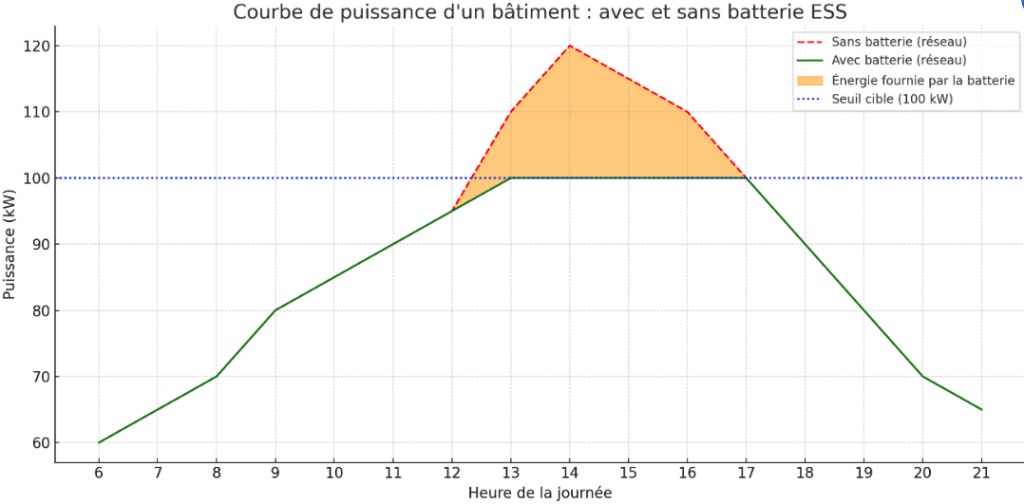
Peak shaving: reducing billable power spikes
Peak shaving consists precisely in clipping or flattening these peaks in consumption to prevent them from becoming the “peak of the month” billed at the power tariff. In concrete terms, it is a question of Reduce the amount of energy purchased from the grid during peak demand hours, to reduce peak charges on the bill.
To achieve this, an ESS (energy storage system) is used, i.e. a battery system as a temporary backup source. In fact, during a peak charge, the battery will Discharge and supply some of the electricity needed by the building, which reduces the power required from the grid.
Outside peak periods, the battery is charged either from the grid (when the building’s demand is lower, or during off-peak hours) or from other local sources if necessary (e.g. solar panels).
For example, imagine that an office building reaches a peak of 120 kW in the middle of the day (air conditioning, equipment running, etc.). Without a battery, HydroQuébec will retain this 120 kW as the maximum power for the month. With a properly sized ESS, it can be decided to limit the contribution from the grid to 100 kW: beyond this value, the battery provides the additional electricity. The peak would then increase from 120 kW to 100 kW – a 17% reduction in peak, resulting in 17% less power costs on the bill for the month in question.
The principle of peak shaving is therefore to smooth out the customer’s load profile : peaks are “shaved” so that consumption from the grid remains as linear as possible, avoiding costly peaks.
From the perspective of the engineering firm or electrical contractor, the implementation of the peak Shaving via a battery implies knowing the customer’s consumption profile well. It is necessary to determine the times at which peaks usually occur (for example in the morning when it opens, or around 4 p.m. when certain machines are started simultaneously, etc.), it is also necessary to determine the power reductions targeted (the threshold not to be exceeded). This information will be used to configure the battery management system.
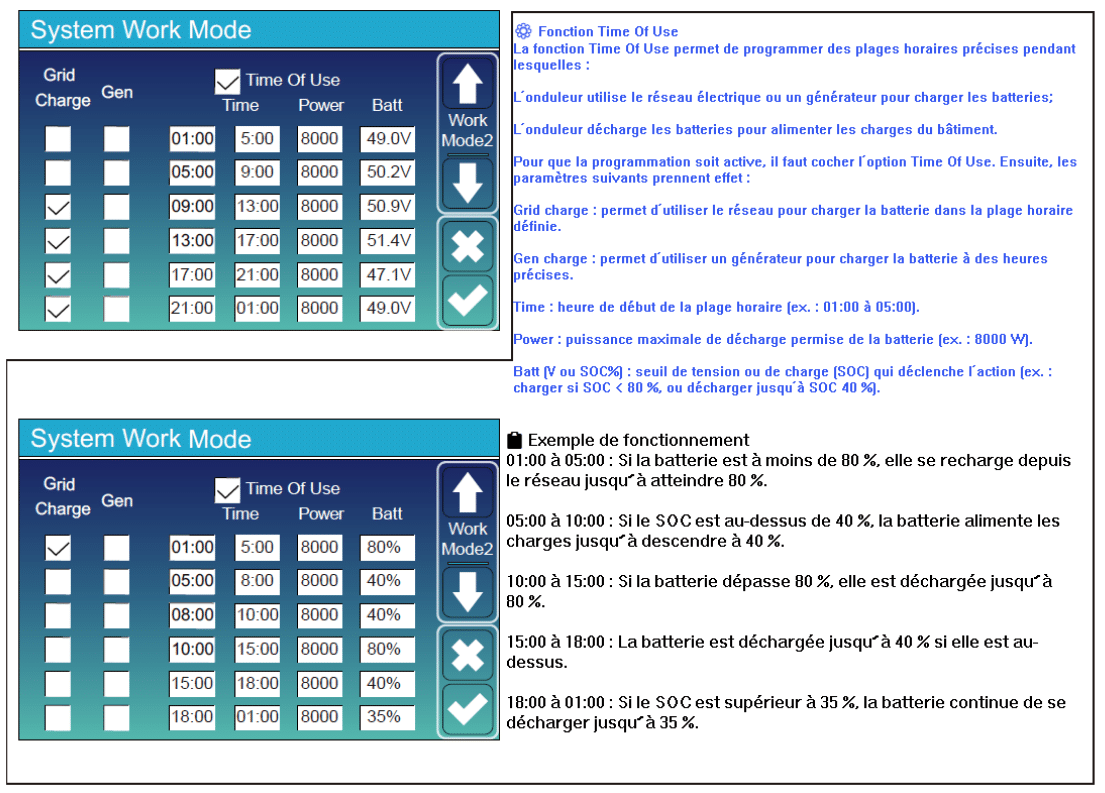
Time of Use Function
An interesting feature offered by several modern hybrid inverters (when coupled with an ESS battery system) is the management according to the Time of Use mode (TOU). This function allows you to Schedule charging and discharging periods of the battery according to predefined time ranges. Even though Hydro-Québec does not yet apply large-scale dynamic rates for its commercial customers (unlike in some international markets), the TOU mode remains relevant. It allows, for example, to force the battery to be recharged during off-peak hours (when the building’s demand is lower) and schedule an automatic discharge during anticipated periods of high consumption. This approach provides greater control over the customer’s load profile, in addition to optimizing the overall performance of the system.
In a future context where variable or incentive rates could become widespread in Quebec (we hope), the Time of Use mode will become an even more strategic tool to maximize savings. For The electrician or the integrator of energy optimization solutions is a feature to be prioritized in the choice of storage equipment and smart inverters.
Real-time power management: smoothing consumption throughout the day
Once a target power threshold is established (e.g., not exceeding 100 kW requested from the grid), the battery system comes into play to manage power in real-time.
In concrete terms, an EMS (Energy Management System) controller continuously monitors the building’s consumption and compares the power demand with the set threshold.
As soon as demand approaches the threshold, the controller orders the battery to take over to supply part of the demand, so that the power taken from the grid remains below the threshold. Conversely, when the building’s demand is below the threshold, the controller instructs the battery to recharge by absorbing the excess available capacity from the grid.
This advanced fine control makes it possible to erase instantaneous fluctuations of the charge.
For example, starting an engine or compressor could cause a very brief but high power pull. Without active management, a short peak of 5 minutes could be enough to set the maximum power of the month. The ESS battery bank can respond almost instantaneously to this type of consumption surge thanks to modern inverters such as Sol-Ark and LuxPowerTek, avoiding the grid seeing it and thus excluding this peak from billing. This storage responsiveness is a major asset: it offers a flexibility that other measures (such as manual load shedding) cannot match.
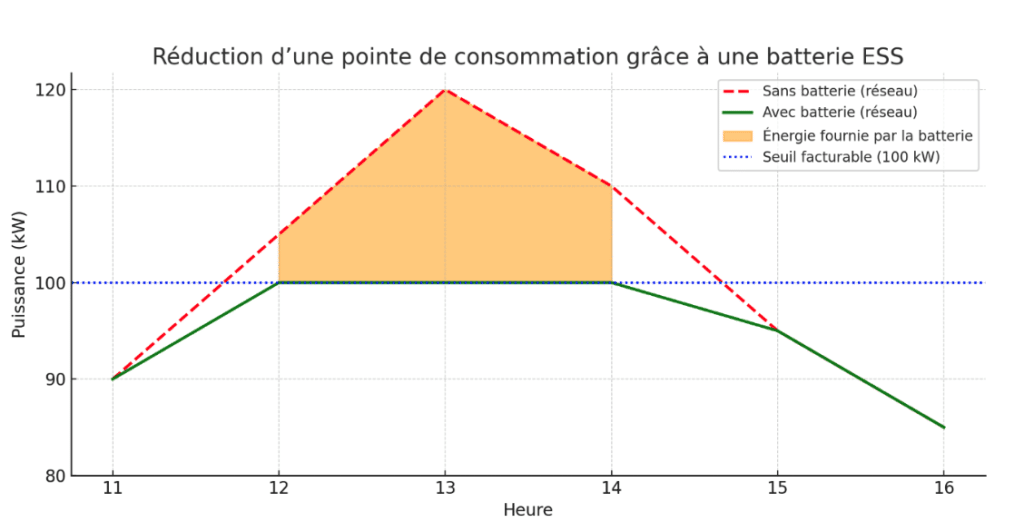
Planning energy to avoid unintentional spikes
It is also important to remember that the battery can be programmed to charge and discharge optimally, depending on the needs of the building. Even though Hydro-Québec does not apply variable hourly rates for Rate M customers (the price per kWh remains stable during the day, except for certain conditions related to consumption blocks), it remains strategic to recharge the ESS during off-peak periods such as at night, in order to avoid creating a new unintentional peak. Indeed, the charging process is intense in itself.
With this in mind, several hybrid inverters allow precise time management thanks to the Time of Use function discussed above. They p allow charging and discharging time slots to be scheduled in advance, according to a daily or weekly schedule. For example, the battery can be set to charge between 1 a.m. and 6 a.m., and then automatically discharge between 4 p.m. and 8 p.m. to support peak consumption.
This approach ensures greater control over the customer’s power profile while avoiding unplanned calls. In addition, if the site is equipped with solar panels, the surplus energy produced at noon can be stored for targeted use at the end of the day.
The integration of the Time of Use mode, combined with intelligent real-time management, makes it possible to optimize both the savings and the overall performance of the ESS system, while preparing the ground for future dynamic pricing in Quebec.
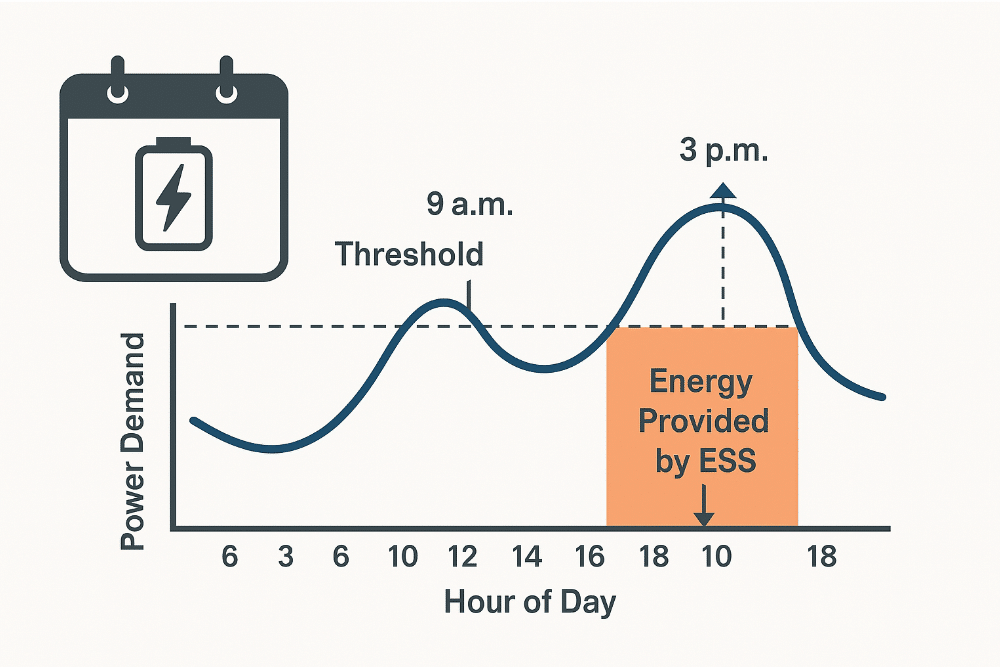
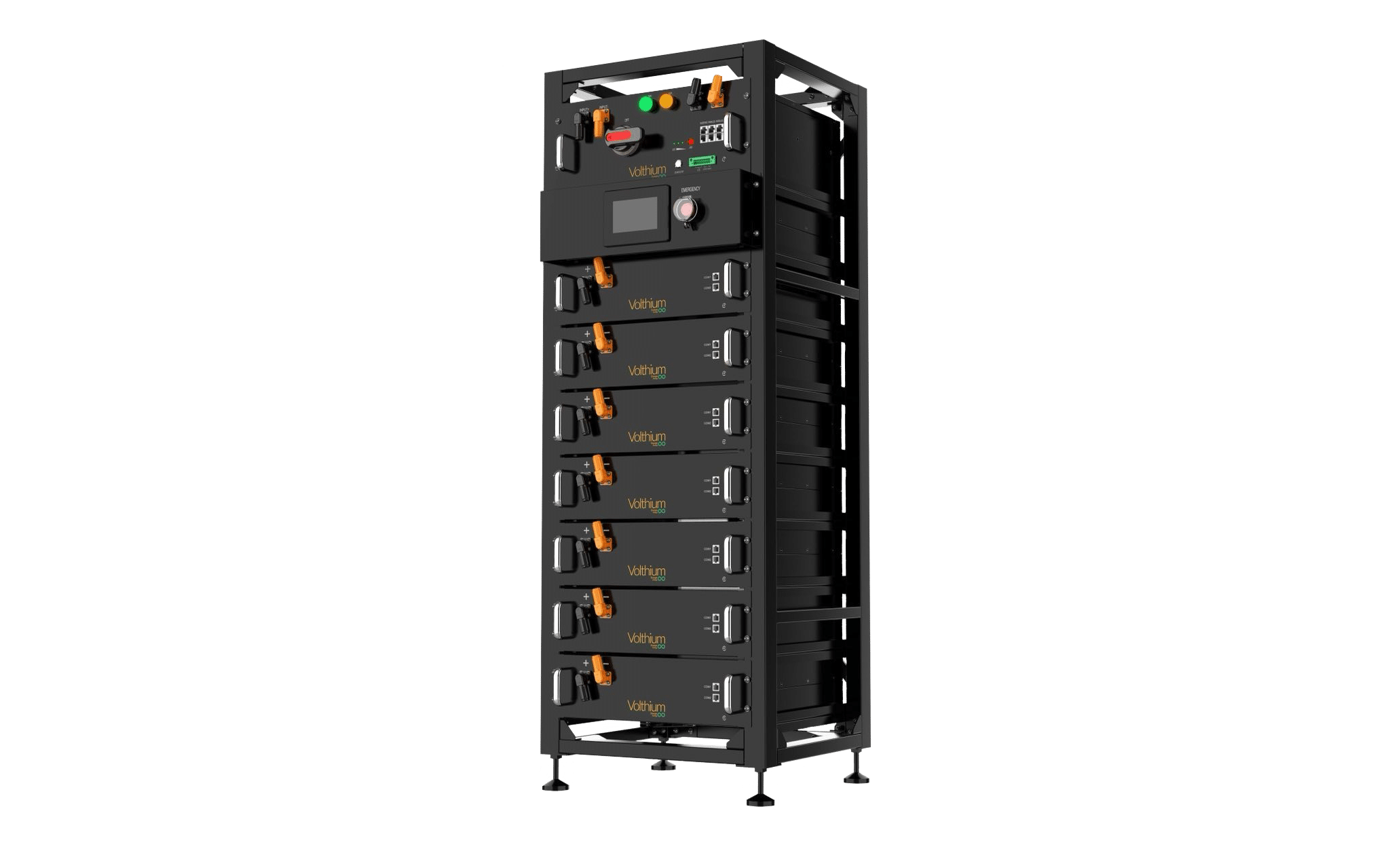
Financial benefits and return on investment (ROI)
The primary objective of an ESS battery system in a commercial environment is to reduce the electricity bill of your customers. The savings are mainly due to the reduction in the power charges charged by HydroQuébec each month. In some buildings, these peak charges can account for 20% or more of the total bill – so reducing them has a significant impact on operating costs. By clipping the ends, you can often Reduce monthly power costs by 10 to 30%, which improves the unit cost of electricity consumed.
In the medium term, these savings justify the initial investment in the battery. the Return on investment of an ESS depends on several factors (system price, size of peaks, current tariff, etc.), but we are seeing more and more projects with relatively short paybacks. For example, case studies have shown payback periods in the range of 4 to 6 years for well-sized commercial batteries. This is due to the combination of substantial monthly savings and the downward trend in the cost of lithium-ion batteries in recent years. Once the investment has been amortized, the savings made each year contribute directly to improving the financial balance sheet of the user company.
It is through our commitment to quality and compliance that we continue to innovate to offer innovative energy solutions to enhance our position as the leader in the lithium battery market.
Additional Benefits
Indirect benefits must also be considered . An ESS battery can add value by serving as a Breakdown backup (backup power for a few minutes or hours, depending on size, allowing for shorter outages or transition to a generator). It can also improve the quality of the power supply (filtering out sudden voltage variations or providing temporary additional power to avoid too high a current draw on the network). These additional benefits, while difficult to monetize, increase the overall attractiveness of the solution to a business customer, in addition to the purely pricing gains.
In Quebec, incentive programs can further improve return on investment (ROI). For example, Hydro-Québec offers a Power Demand Management (PDM) option to its business customers, who pay a credit at the end of winter based on the power reductions made during major network peaks. Credits can go up to $78 per kW of effective reduction during the winter peak – a battery greatly facilitates this kind of performance by providing the necessary energy during those few critical hours of the year.
By combining classic peak shaving (savings on each monthly bill) and participation in such programs (additional income in the form of annual credits), the return on investment of an SSE becomes even more attractive.
Synergies with other energy efficiency measures
The integration of a battery system is generally part of a global energy efficiency approach. To maximize the benefits for your customers, it is wise to combine it with other complementary actions or technologies:
- Efficient equipment and load management: First and foremost, reduce overall consumption through traditional measures (LED lighting, high-efficiency motors, automated HVAC management, etc.) decreases baseline of demand. Lower baseline demand makes it easier to shave the remaining peaks. In addition, the battery will be able to cover a greater proportion of peaks once energy waste has been eliminated. The Demand management (e.g., shifting certain non-critical uses to off-peak hours) goes well with battery storage: while some loads can be temporarily cut off or shifted (thanks in particular to the products offered by SINOPÉ), this reduces the magnitude of the peak to be managed by the battery, or allows a smaller battery to achieve the same result.
- Local energy production (self-generation): The addition of renewable energy sources, such as photovoltaic solar panels, creates a clear synergy with an SSE. This is because solar production often peaks in the middle of the day, which may or may not correspond to the customer’s consumption peaks. A battery allows you to store excess solar energy at noon to release it during late afternoon or the following morning peaks, thus maximizing self-consumption. Your customers benefit from a double saving: reduction in purchases from the grid thanks to solar energy, and reduction in power costs thanks to the smoothing made possible by storage. Similarly, for companies with backup generators, hybrid strategies where the generator and battery work together during very high demands (the battery fills the power surges and then a generator can take over for extended peak periods).
- Fare Programs and Incentives : As mentioned above, HydroQuébec offers financial incentives for power reduction during peak grid periods (GDP option in winter, dual-energy rate, etc.). An ESS gives increased flexibility for Respond to load shedding calls without impacting the customer’s operations. For example, during a critical peak advisory in winter, the battery can deliver several hundred kilowatts during the requested hour, saving the customer from drawing from the grid and earning the associated credit (up to $78/kW in the winter . This synergy with state-of-the-art management programs turns the battery into a source of additional revenue (in the form of savings or discounts), in addition to its role as a regular monthly savings.
Conclusion: Lithium ESS, a Powerful Tool for Commercial Electricians
All in all, the ESS lithium battery system is proving to be a powerful tool for commercial electricians who want to help their customers reduce their energy costs. By popularizing peak shaving and power management, we realize that the battery acts as a Smart energy buffer : it stores electricity when there is too much or when it is cheaper, then releases it when the building’s need exceeds what would be ideal to draw from the grid.
The result is a smoother load curve, reduced power charges on Hydro-Québec bills, and often an attractive payback time for the customer. All of this is part of a broader strategy of energy efficiency and modernisation of electrical installations (smarter buildings, integration of renewable energies, response to grid signals, etc.).
For the electrical entrepreneur, offering this type of storage solution to its customers means positioning itself at the forefront of innovation in energy efficiency while providing tangible value in dollars saved. ESS lithium batteries, once reserved for backup applications or pilot projects, are now becoming a concrete ally for “cap” the electricity bill and build a more sober and smarter energy future.
Sources of the article
Elum Energy (technical blog on peak shaving): elum-energy.com
Energy Storage Industry Case Studies (ROI and Peak Management): csemag.com
- Peak Forecasting for Battery-based Energy Optimizations in Campus Microgrids : none.cs.umass.edu
Demand management option (HydroQuébec, credit details): hydroquebec.com
The figures and examples presented are based on the pricing in effect in Quebec in 2025 and illustrate the savings potential that can be achieved with ESS battery systems in commercial settings in Quebec.
